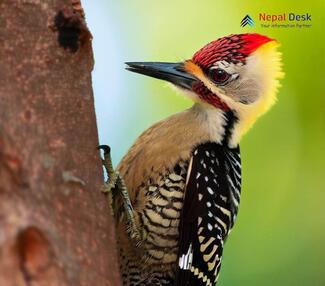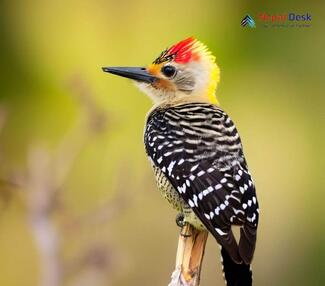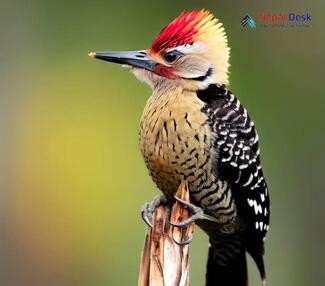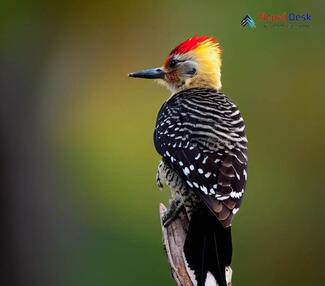The Yellow-crowned Woodpecker (Leiopicus mahrattensis) is a fascinating and unique bird species that calls the forests of Nepal home. With its striking physical features, distinctive habitat preferences, and intriguing breeding behaviors, the Yellow-crowned Woodpecker is a species that bird enthusiasts will love to learn about. In this article, we will explore the taxonomy and physical characteristics of this captivating bird, as well as its habitat, diet, breeding patterns, and significance in Nepal's wildlife.
Taxonomy & Physical Features
Belong to the family Picidae, the Yellow-crowned Woodpecker is a medium-sized woodpecker adorned with striking plumage. Both sexes have golden-yellow crown feathers contrasting against a black face mask and throat patch. The upperparts showcase a combination of blackish-brown hues alongside white bars while the underparts display a creamy-white shade. Adult males can be distinguished by their red nape patch – an absence of such coloration typifies adult females.
Habitat & Diet
Widely distributed across Nepal's Terai region and parts of India, the Yellow-crowned Woodpecker favors deciduous forest landscapes interspersed with patches of open grassland or scrub vegetation. They are known to perch on low branches or tree trunks when foraging for food. Their diet primarily comprises insects such as ants, beetles, and termites – mainly extracted from crevices in tree trunks using their sharp beak. Occasionally, they will supplement their diet with fruits and seeds.
Breeding & Nesting
Yellow-crowned Woodpeckers are primarily monogamous breeders who often return to previous nesting sites nestled within deserted tree cavities or branches. Males exhibit an active role in nest excavation – utilizing their reinforced bills and zygodactyl feet to chisel perfect cylindrical homes. Both parents share the responsibility of incubating eggs which usually hatch within two weeks from laying. Post-hatching, parents diligently provide sustenance until fledglings are competent for solo flight – a process lasting approximately 3 weeks.
Presence in Nepal
The Yellow-crowned Woodpecker plays a vital role in maintaining ecosystem health – functioning as both natural pest controllers as well as seed dispersers. Their preference for the Terai region renders them an invaluable icon for local wildlife enthusiasts and bird watchers alike. Though not currently endangered, habitat loss from deforestation poses a potential risk to their long-term survival. Ongoing efforts to protect their habitat are imperative for the preservation of these unique avian gems within Nepal's rich biodiverse backdrop.
In conclusion, the Yellow-crowned Woodpecker is a remarkable species that contributes significantly to the ecological balance of Nepal's forests. Their striking appearance and captivating behavior provide ample opportunities for bird lovers to observe and appreciate their incredible splendor. Understanding their biology and raising awareness about this lesser-known species may inspire future conservation efforts, ensuring their long-lasting presence among Nepal's diverse wildlife population.




